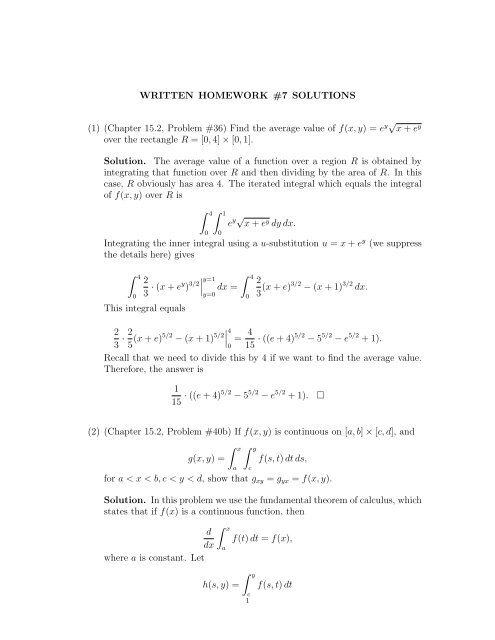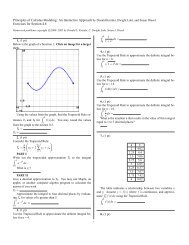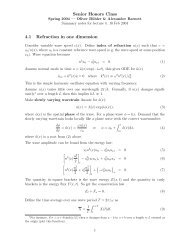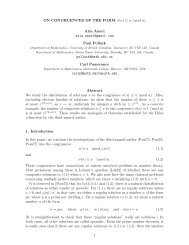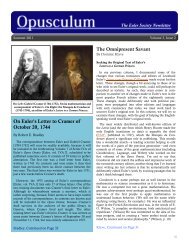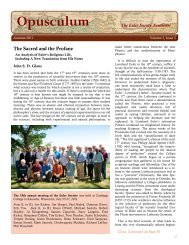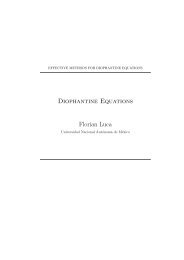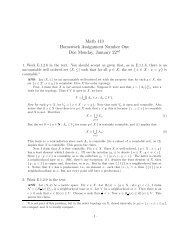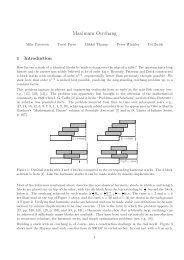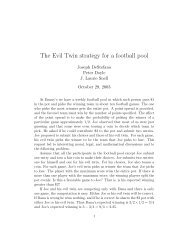WRITTEN HOMEWORK #7 SOLUTIONS (1) (Chapter 15.2, Problem ...
WRITTEN HOMEWORK #7 SOLUTIONS (1) (Chapter 15.2, Problem ...
WRITTEN HOMEWORK #7 SOLUTIONS (1) (Chapter 15.2, Problem ...
You also want an ePaper? Increase the reach of your titles
YUMPU automatically turns print PDFs into web optimized ePapers that Google loves.
<strong>WRITTEN</strong> <strong>HOMEWORK</strong> <strong>#7</strong> <strong>SOLUTIONS</strong><br />
(1) (<strong>Chapter</strong> <strong>15.2</strong>, <strong>Problem</strong> #36) Find the average value of f(x, y) = e y√ x + e y<br />
over the rectangle R = [0, 4] × [0, 1].<br />
Solution. The average value of a function over a region R is obtained by<br />
integrating that function over R and then dividing by the area of R. In this<br />
case, R obviously has area 4. The iterated integral which equals the integral<br />
of f(x, y) over R is<br />
� 4�<br />
1<br />
e y√ x + ey dy dx.<br />
0<br />
0<br />
Integrating the inner integral using a u-substitution u = x + e y (we suppress<br />
the details here) gives<br />
� 4<br />
2<br />
3 · (x + ey ) 3/2<br />
�<br />
�<br />
0<br />
This integral equals<br />
� y=1<br />
y=0<br />
� 4<br />
2<br />
dx =<br />
3 (x + e)3/2 − (x + 1) 3/2 dx.<br />
0<br />
2 2<br />
·<br />
3 5 (x + e)5/2 − (x + 1) 5/2<br />
�<br />
�<br />
� 4<br />
=<br />
0<br />
4<br />
15 · ((e + 4)5/2 − 5 5/2 − e 5/2 + 1).<br />
Recall that we need to divide this by 4 if we want to find the average value.<br />
Therefore, the answer is<br />
1<br />
15 · ((e + 4)5/2 − 5 5/2 − e 5/2 + 1). �<br />
(2) (<strong>Chapter</strong> <strong>15.2</strong>, <strong>Problem</strong> #40b) If f(x, y) is continuous on [a, b] × [c, d], and<br />
g(x, y) =<br />
� x � y<br />
a<br />
c<br />
f(s, t) dt ds,<br />
for a < x < b, c < y < d, show that gxy = gyx = f(x, y).<br />
Solution. In this problem we use the fundamental theorem of calculus, which<br />
states that if f(x) is a continuous function, then<br />
d<br />
dx<br />
where a is constant. Let<br />
� x<br />
a<br />
h(s, y) =<br />
f(t) dt = f(x),<br />
� y<br />
c<br />
1<br />
f(s, t) dt
2 <strong>WRITTEN</strong> <strong>HOMEWORK</strong> <strong>#7</strong> <strong>SOLUTIONS</strong><br />
be the inner integral in the definition of g(x, y); notice that h is a function of<br />
s and y instead of s, t. Then<br />
∂ ∂<br />
g(x, y) =<br />
∂x ∂x<br />
� x<br />
a<br />
h(s, y) ds = h(x, y).<br />
We now differentiate h(x, y) with respect to y:<br />
gxy(x, y) = ∂<br />
� y<br />
∂<br />
h(x, y) = f(x, t) dt = f(x, y).<br />
∂y ∂y c<br />
We can repeat the same procedure on gyx to find that gyx = f(x, y) as well; in<br />
particular, we can repeat the entire argument performed above with the roles<br />
of x, y swapped, after interchanging the order of integration in the definition<br />
of g:<br />
g(x, y) =<br />
� x � y<br />
a<br />
c<br />
f(s, t) dt ds =<br />
� y � x<br />
c<br />
a<br />
f(s, t) ds dt. �<br />
(3) (<strong>Chapter</strong> 15.3, <strong>Problem</strong> #52) Evaluate the following integral by reversing the<br />
order of integration:<br />
� 1<br />
0<br />
� 1 � 1<br />
e x/y dy dx.<br />
0<br />
x<br />
Solution. The inequalities describing the region of integration are 0 ≤ x ≤<br />
1, x ≤ y ≤ 1. If we interchange the order of integration, we can describe the<br />
region of integration using the different set of inequalities 0 ≤ y ≤ 1, 0 ≤ x ≤<br />
y. Therefore, the original iterated integral equals<br />
� y<br />
0<br />
e x/y � 1<br />
dx dy = ye x/y<br />
�<br />
�<br />
0<br />
� x=y<br />
x=0<br />
� 1<br />
dy =<br />
0<br />
y · e − y dy = y2<br />
2<br />
�<br />
�<br />
(e − 1) � 1<br />
= e − 1<br />
0<br />
. �<br />
2<br />
(4) (<strong>Chapter</strong> 15.3, <strong>Problem</strong> #62) In evaluating a double integral over a region D,<br />
a sum of iterated integrals was obtained as follows:<br />
��<br />
D<br />
� 1 � 2y<br />
� 3 � 3−y<br />
f(x, y) dA = f(x, y) dx dy + f(x, y) dx dy.<br />
0<br />
0<br />
Sketch the region D and express the double integral as an iterated integral<br />
with reversed order of integration.<br />
Solution. The region D is described by the inequalities 0 ≤ y ≤ 1, 0 ≤ x ≤<br />
2y and 1 ≤ y ≤ 3, 0 ≤ x ≤ 3 − y. This region is a triangle with vertices at<br />
(0, 0), (1, 2), and (3, 3):<br />
1<br />
0
<strong>WRITTEN</strong> <strong>HOMEWORK</strong> <strong>#7</strong> <strong>SOLUTIONS</strong> 3<br />
This region is evidently described by inequalities 0 ≤ x ≤ 2, x/2 ≤ y ≤<br />
3 − x, so the original integral is equal to<br />
� 2�<br />
3−x<br />
f(x, y) dy dx. �<br />
0<br />
x/2<br />
(5) (<strong>Chapter</strong> 15.4, <strong>Problem</strong> #26) Use polar coordinates to find the volume of the<br />
solid bounded by the paraboloids z = 3x 2 + 3y 2 and z = 4 − x 2 − y 2 .<br />
Solution. The first task is to find the intersection of these two surfaces.<br />
Equating the two functions of x, y, we obtain 4x 2 + 4y 2 = 4, or x 2 + y 2 = 1.<br />
So the intersection of these two surfaces is x 2 + y 2 = 1, z = 1. A quick sketch<br />
of these surfaces (which we omit here) shows that the region bounded by the<br />
surfaces is given by inequalities 0 ≤ x 2 + y 2 ≤ 1, 3x 2 + 3y 2 ≤ z ≤ 4 − x 2 − y 2 .<br />
Therefore, the volume of this region is given by the double integral<br />
��<br />
D<br />
4 − x 2 − y 2 − (3x 2 + 3y 2 ) dA,<br />
where D is the closed disc x 2 + y 2 ≤ 1. This disc is described by polar<br />
inequalities 0 ≤ r ≤ 1, 0 ≤ θ ≤ 2π. Therefore the integral we want to<br />
calculate is equal to<br />
� 2π�<br />
1<br />
0<br />
0<br />
(4 − r 2 − 3r 2 ) · r dr dθ =<br />
� 2π �<br />
0<br />
2r 2 − r 4<br />
�<br />
�<br />
� r=1<br />
r=0<br />
�<br />
dθ = 2π. �<br />
(6) (<strong>Chapter</strong> 15.4, <strong>Problem</strong> #38) Let D be the disk with center the origin and<br />
radius a. What is the average distance from points in D to the origin?<br />
Solution. Let a particular point have polar coordinates (r, θ). Then the<br />
distance of this point from the origin is r. Therefore, we wish to evaluate the<br />
double integral
4 <strong>WRITTEN</strong> <strong>HOMEWORK</strong> <strong>#7</strong> <strong>SOLUTIONS</strong><br />
��<br />
D<br />
r dA.<br />
(Recall that at the end, we will need to divide our result by the area of<br />
D to obtain the average distance.) In polar coordinates, D is described by<br />
0 ≤ r ≤ a, 0 ≤ θ ≤ 2π. Therefore,<br />
��<br />
D<br />
� 2π<br />
r dA =<br />
0<br />
� a<br />
0<br />
r 2 dr dθ = 2π a3<br />
3 .<br />
The area of D is πa 2 , so the average distance of points from the origin is<br />
2π a3<br />
3<br />
1 2a<br />
· = . �<br />
πa2 3


